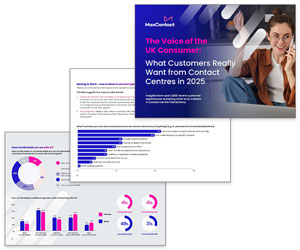Let’s face it, contact centre workforce management (WFM) is a bit of a minefield.
The goal of WFM is obvious enough. You want the right number of agents with the right skill levels in place for every shift. Get it right and you maximise revenue opportunity, reduce churn rates and create better customer experiences, while lowering operational costs.
Get it wrong and the opposite happens. Either you’re left with too many agents, or you’re left with too few. In the first instance, agents are left twiddling their thumbs while you hemorrhage money. In the second, customer dissatisfaction grows and overworked staff contemplate less stressful futures elsewhere.
Now add the pandemic into the mix, and the fact that team leaders can’t physically judge the overall productivity of their agents by simply scanning the room. In these circumstances, WFM becomes trickier still.
Getting the Balance Right?
So how do contact centre managers go about getting the balance right? Traditionally, it’s been a mix of intuition, experience and basic number crunching, but this analogue approach is no longer enough.
That’s because scheduling staff shifts in modern contact centres is more complex than ever. It starts with a forecast of the likely number of inbound enquiries, based on previous experience and known upcoming events. Anything from a bank holiday to the start of your latest marketing campaign can seriously impact your inbound forecasting.
Then you have to match that forecast to your available agents, while considering rotas, workload, skill sets, contracted hours, holidays and workforce wellbeing, among other factors.
And depending on your business, you may have to factor in the SLAs you offer your customers, and the ever-changing metrics your C-suite uses to measure the health of the business.
And let’s not forget that contact centres are often omnichannel these days, meaning your responsibility isn’t just to customers who pick up the phone. If you advertise SMS, web chat, email and social media as ways to get in touch, you’d better have the right people on hand to answer digital queries in a timely manner.
We could go on, but you get the picture. Like we say, it’s all a bit of a minefield.
Workforce Management: The Old-School Approach
So how do contact centres absorb this tsunami of information, create an accurate forecast of need and allocate agent resources appropriately?
Many of them still do it using a spreadsheet.
It’s an admirably old-school approach, but it makes WFM a hugely complex and time-consuming task, as businesses manually try to match call volumes to staff availability while also meeting all the criteria mentioned above.
The spreadsheet method also introduces the very real possibility of human error. Put the wrong figure in the right box, or the right figure in the wrong box, and your entire plan could be pushed out of balance.
In fact, this manual WFM approach simply isn’t equipped to handle the complexities of a modern call centre. Many WFM spreadsheets use what’s called an Erlang formula, a mathematical calculation for matching staff numbers to service needs.
If that sounds high-tech, don’t be fooled. The Erlang formula can’t take into account peaks and troughs in call rates, priority callers, omnichannel solutions or scores of other criteria that affect the resource requirement of contact centres today. It’s an outdated solution that errs on the side of caution and frequently leads to overstaffing.
Modern Workforce Management: Accuracy and Insight
The alternative is a digital WFM solution. The best of these use sophisticated statistical analysis to make sure call centres always have the right staff in place to reach their goals.
They do all the number crunching for you, freeing up management time for more productive tasks. They take away both human error and the over-reliance on outdated mathematical formulas.
So how do they work? Well, MaxContact’s industry-leading WFM uses statistics from the last 12 months to create highly accurate forecasts based on the actual reality of your business, rather than vague assumptions about the sector or educated guesswork. By analysing data from a full year, the algorithm accounts for seasonal peaks, historical trends and more. By doing so, it provides a highly accurate and cost-effective workforce schedule.
It takes all this information and automates the labour-intensive task of shift creation. This takes minutes with MaxContact, though it can take much longer with competing solutions. Rotas can then be assigned to agents with a single click, via email, SMS or calendar integration.
Predicting the Future
And MaxContact’s WFM goes further. It lets you build ‘what if’ scenarios, predicting future performance based on past performance and new variables. For example, if you want to answer more calls or reduce call waiting times, feed the figures into the WFM solution and it will estimate the extra resource you need to meet your goals.
Importantly, it also allows you to measure the performance of home-based agents, and provides real-time reporting on call traffic, cost analysis and more. This data-driven approach makes it much simpler for contact centres to adopt permanent remote or hybrid working models without sacrificing efficiency.
In addition, it makes it much easier to fill in gaps in cover with part-time, home-based agents who need to fit work around childcare or other responsibilities. By doing so, MaxContact WFM gives you the flexibility you need to succeed in a new world of work.
MaxContact’s powerful WFM solution automates a highly labour-intensive process and adds a whole new level of precision. Use it to make the most of your talent, while reducing churn, minimising costs and adopting new, more flexible ways of working. It’s a big step up for your staff, your business, and your customer experience.
This blog post has been re-published by kind permission of MaxContact – View the Original Article
For more information about MaxContact - visit the MaxContact Website
Call Centre Helper is not responsible for the content of these guest blog posts. The opinions expressed in this article are those of the author, and do not necessarily reflect those of Call Centre Helper.
Author: MaxContact
Published On: 3rd May 2021 - Last modified: 4th May 2021
Read more about - Guest Blogs, MaxContact






 MaxContact is the AI-powered customer engagement software that helps you turn every customer conversation into a high-impact, revenue-driving moment. We empower your teams to connect smarter, perform better, and scale faster – without losing the human touch.
MaxContact is the AI-powered customer engagement software that helps you turn every customer conversation into a high-impact, revenue-driving moment. We empower your teams to connect smarter, perform better, and scale faster – without losing the human touch. 
































